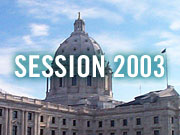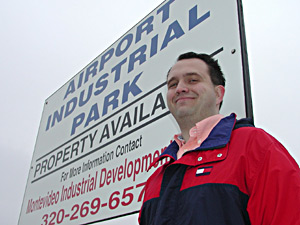Audio
Photos
More from MPR
Resources
Your Voice
| ||||||||||||||||||||||||||||||||||||||||||||||||||||||||||
In search of outstate "JOBZ"
April 7, 2003
Governor Pawlenty is calling his "JOBZ" program "the mother of all economic development incentives." Communities in outstate Minnesota are already compiling their evidence to convince state officials that their town needs the extra boost.
Montevideo, Minn. — On a recent day, cars leave the parking lot on a lunch break at Microdynamics. The electronics manufacturer is one of a half-dozen companies in the Montevideo Airport Industrial Park. Scott Marquardt stands in a empty parking space and points out that a number of nearby plots remain unfilled.
"There is property available here owned by the Industrial Development Corporation that they have been analyzing as a possible source for a 'JOBZ' zone," Marquardt says. Marquardt is the director of economic development for the city of Montevideo, in Chippewa County.
 | |||
Chippewa is one of five western Minnesota counties planning a unified bid for one of Governor Tim Pawlenty's tax-free "Job Opportunity Building Zones," or JOBZ. The JOBZ program, which was one of the first bills introduced in the legislature, would create pockets of land outside the metro area that are essentially tax-free.
The proposal is still awaiting approval by lawmakers. But communities in outstate Minnesota are already compiling their evidence to convince state officials that they're the ones who need the extra boost. The Department of Trade and Economic Development would choose the locations of the zones.
Businesses that start or expand in a zone would be free from corporate income tax. If you work in the zone, your personal income would also be exempt from state taxes. The bill contains pages of various, smaller tax breaks. The tax-free status remains for 12 years.
As it stands now, the JOBZ bill would allow 10 primary zones around the state. Each of those 5,000-acre zones could be split into 20 non-contiguous tax-free pockets. Marquardt would like to see one of those right here in this industrial park.
 | |||
"It's going to take a while for this bill to go through, but when it does it's going to be crunch-time and we'd better have a plan in place," Marquardt says. "So we're analyzing ahead of time what might be possible sites. Is it a few acres in this park, is it a few acres on the other side of town, is it a few acres here or there?"
No Minnesota community with a ghost of a chance wants to fall behind in the planning process, even if planning at this point is still something of a guessing game. The governor has at times cast the JOBZ program as a radical boost for pockets of economic wasteland, plots of land that really have nothing else going for them. But Montevideo City Manager Steve Jones thinks in practice partially developed sites will have an edge.
"If they give us an allocation but we have to spend three years siting and building an industrial park, I don't think that's what they want to see," Jones says. "I think they want to see an area where, if we get the allocation, next year we can get a businesses in there."
Here in far western Minnesota, the shadow of South Dakota looms over any economic development. In many ways, tax incentives across the border are unbeatable: No corporate income tax, no personal income tax, no business inventory tax. Businesses have indeed left the area or chosen to expand in Sioux Falls, Watertown, and Brookings. Jones says the JOBZ program could help make up some of the difference.
"Honestly, I don't believe this is a perfect system. The governor says it isn't either, and I think he understands that. But we've got to try something," Jones says. "Because a lot of growth is not happening in this region."
 | |||
Two western Minnesota economists at the University of Minnesota Morris say it's clear the region needs help. They're not sure Pawlenty's plan is the best medicine, but they're glad for the focus on rural areas.
Economists Bart Finzel and Pareena Lawrence point to the area's aging workforce, with young people leaving for other opportunities. They're also concerned by underemployment levels of 15 to 20 percent. "Underemployed" workers are workers who are overeducated, underpaid, or working too few hours. In other words, there are not enough skilled jobs for the area's labor force, so attracting new companies is key.
Finzel and Lawrence worry the focus on taxes might substitute for a more "holistic" approach that includes investments in roads, telecommunications and education.
"In an effort to compete on the same basis that the Dakotas compete with Minnesota, we might be undermining what, after all, has historically led to greater incomes and greater wealth generation in this state," Finzel says.
But "given the (state) budget the way it is, are we going to see that holistic program that would be best?" says Lawrence. "Probably not."
 | |||
The economists say improving the region's quality of life may be just as important as taxes for attracting companies and workers. But new companies in the zones will be exempt from property taxes that would otherwise fund schools and other community improvements.
The governor has talked about luring high technology companies to Minnesota's outstate areas. Lawrence says there's nothing wrong with technology, as long as the companies have some reason other than taxes to locate in rural Minnesota. Good signs would be businesses that require a substantial capital investment in equipment and facilities, and that use the natural amenities of the region. A promising example might be new agricultural processing companies. She might be more skeptical of something like a software company.
"We might be attracting the type of businesses we don't want, that come here just for the purpose of getting this tax incentive and then move somewhere else in a few years," Lawrence says. "Now, that said, is this a bad idea? No, it's good that we're doing something to address the problems of rural Minnesota."
Various rural enterprise zones and tax incentives have come and gone over the years. One that remains is the Border Enterprise Zone program, now 20 years old. Five cities continue to use the border city tax credits: Breckenridge, Dilworth, East Grand Forks, Moorhead, and Ortonville.
Blair Johnson is an Ortonville accountant and a board member on the Economic Development Authority. He has managed the border tax credits for the past three years.
 | |||
"It's been a good thing," Johnson says. "As you can see, our main street here in Ortonville is pretty active for a small town. A lot of small town main streets are kind of dying out. Ours seems to be doing pretty well, and part of that is because of the enterprise zones."
Businesses that start up or expand in Ortonville can apply for a tax credit for each new job they create. The town has given credits over the years for 768 new jobs. Twenty-four existing companies have expanded under the program, and 22 new businesses have come to town. Most are commercial, including a carwash, a hotel, and an optometrist.
Some undoubtedly would have added the jobs here with or without the border city credits. Steve Roggenbuck is not one of those. In 1995, Roggenbuck was considering whether to set up his autobody and glass shop in Ortonville or across the river in South Dakota. The border credit was a big factor in his choice to stay in Minnesota.
"It's kind of a mess down here because we're in the middle of remodel job right now," Roggenbuck warns as he gives a tour of his business. The original two-man shop has grown to eight employees, with a tax credit for each. The current construction in his lower level garage may allow him to apply for credits once again.
"If they're available, we will do it," Roggenbuck says. "It's based on (adding) more employees, and we have to determine when we're done if we will hire more people."
There are big differences in scale between the border city enterprise zones and Pawlenty's JOBZ proposal. The border zones helped keep a dentist on main street Ortonville; the JOBZ program envisions major industrial initiatives in the state's most depressed areas. The border program offers a few thousand dollars here and there; by comparison, the tax-free benefits of a JOBZ zone could mean millions. As a result, the placement of zone boundaries will be closely watched. They could be bitterly fought by companies and cities who find themselves on the wrong side of the line.
The JOBZ program still needs to pass the legislature, and no one expects economic miracles. Still, just as when the border zones were created 20 years ago, rural Minnesota seems anxious for whatever help it can get.
|
News Headlines
|
Related Subjects
|


